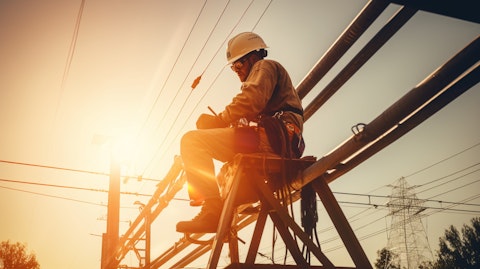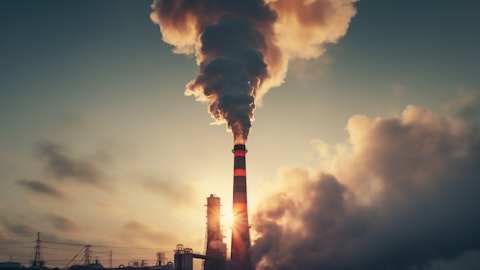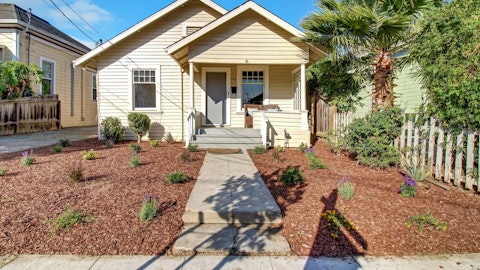E.ON SE (PNK:EONGY) Q4 2023 Earnings Call Transcript March 13, 2024
E.ON SE isn’t one of the 30 most popular stocks among hedge funds at the end of the third quarter (see the details here).
Iris Eveleigh: Good morning, everyone. Dear analysts, the investors, a warm welcome from my side to our Full Year 2023 Results Call. I’m here with Leo and Marc, who will present our results to you. As always, we will leave enough room for your questions afterwards. And also, as always, please stick to the 2 questions through each. With that, I hand over to you, Leo.
Leonhard Birnbaum: Yes. Thanks, Iris. Good morning also from my side. I am here with Marc. Today, he’s still my CFO, and he will remain that until the 1st of June, but I’m very proud before I get to the 2023 numbers and our revised outlook that also we have been able to very smoothly figure out a great succession for Patrick Lammers with Marc, who happily will take over the new challenges, which a new job we’ll offer to him, but as I said, he will stay around for a few more months to come. So where are we today? Maybe 2 words. Today, we are actually talking to you from our brand-new testing lab in Essen. So for once, we have actually decided not to broadcast from a conference room, but rather from a real-life facility in which you see where all the investments are going to — which we are going to announce today and explain to you today.
This is one of the examples how E.ON is driving the energy transition forward. So let me now turn to my 4 key messages. First, 2023, we have seen a strong delivery, the strongest company performance since I took over as CEO, actually 3 years ago. And it makes me proud that we have not only delivered great financials, but also that we are able — and shown that we are able to grow. Second, we will emphasize today that this is the right time to step up to the next big investment cycle. And we will continue to deliver on a unique once in a lifetime, once in a generation growth opportunity. And for E.ON, this means that we are upping our investment plan to €42 billion by 2028, as you have seen. Third, I want to emphasize that we are not only delivering against financials, not only growing, but we are also delivering against our aspirational and sustainability targets, as well as against our claim to pioneer the digitization in the energy sector.

A worker on a ladder, repairing the electrical power transmission lines.
And fourth, we will actually fund this growth from a strong balance sheet and create significant shareholder value. I’ll touch on all these points a little bit, but Marc will then detail some of them more later. On my first message, 2023 was again a year full of challenges. War in Ukraine, interest rate turnaround, economic downward trend in Europe, a continuous rise of geopolitical risks. Nothing of that has changed the continued delivery, the continued performance of E.ON. With an adjusted group EBITDA of €9.4 billion, we delivered results that have significantly exceeded our expectations for the 2023 financial year. And actually, in both our segments, Energy Networks and Customer Solutions grew in most of our market’s year-on-year. Finally, our investment rose by around €1.7 billion to €6.4 billion from a starting base of €4.7 billion.
And this accelerated growth momentum underpins the validity of our strategy. This growth momentum I just mentioned stems from a supportive political environment for E.ON. And this environment becomes evident in the grid action plan of the European Commission. This grid action plan has put grid expansion at the top of the energy transition agenda, something that was unthinkable just a few years ago. The growth momentum also becomes evident in the constructive reform of the European electricity market design. All calls for more government interventions were met with a pretty clear signal. The key to a new energy future is actually more private investments. And all of that has translated into even more aspirational targets. And all of that, again, strongly supports E.ON’s investment case.
See also 11 Best Dividend ETFs To Buy and 10 Best Commodity ETFs.
Q&A Session
Follow E.on Ag -Sponsored Adr (OTC:EONGY)
Follow E.on Ag -Sponsored Adr (OTC:EONGY)
Receive real-time insider trading and news alerts
And we see the impact already in our day-to-day operations, not only in stated ambitions. For instance, customer connections request from customers in Germany have increased by 75% within 1-year to more than 400,000 following the increasing renewable trend. But I want to emphasize that we are seeing growth momentum not only in Germany, but in all our markets. Likewise, updated decarbonization targets in the industrial and housing sectors drive the need for further energy efficiency. They created an increased customer demand for tailored infrastructure solutions to decarbonize. And we are tackling this within our Energy Infrastructure Solutions business, investments in this area have increased by 30% year-over-year. And this growing relevance of the now stand-alone segment leads to our new 3 segment structure.
Energy Networks, Energy Infrastructure Solutions and Energy Retail. That’s all that is just as simple. Energy Networks contains our regulated business for the energy transition, which makes E.ON the leading DSO in Europe. Energy Infrastructure Solutions includes our long-term contracted activities such as district heating and cooling networks in urban areas, integrated energy infrastructure for industrial and for commercial customers. And in Energy Retail, we have proved to be the best owner when it comes to operating our customer portfolio for the commodity activities and for the solutions part of the B2C business, and we do not only manage this business as a strong cash contributor. We also seize the opportunity of leveraging our commodity portfolio to accelerate the growth of our solutions portfolio.
And now let me just briefly flip through these segments and our growth plan for all of them. In Energy Networks, it’s now all about delivery. The majority of the investments we are announcing today will be allocated here. And as the CEO, in many discussions, I’ve been asked whether we have the preconditions in place to deliver. And the clear answer is, yes, and to highlight that, let me just touch on some critical aspects and how we manage them that are always mentioned in the discussions. First, operations. Proof of evidence, we are successful in attracting a skilled workforce. In 2023, we have hired more than 5,000 new colleagues on a gross basis in networks only — 11,000 in total, 5,000 in networks only. And that despite tight labor markets.
And we are fully confident that we can attract more than 13,000 additional talents there by 2028. So we have the people. Second, supply chain. We are working on this topic already since years. Despite €1.7 billion higher investments, we have not encountered a single bottleneck in the supply chain in the last year, so much for us having this under control. How have we done that? Well, we have worked on standardization, on better demand forecasting, on process improvements in our energy asset management and we have worked with our suppliers to increase their resilience and increase their capacity. Third, permitting, and we see really improvements in several areas, and so we are confident that this will not be the crucial bottleneck. Because of that and many other improvements, which we have done in many other areas, we can assure you we can deliver, and we will deliver our accelerated investment program.
As responsible corporate citizens, we are also putting however, significant efforts on affordability when it comes to the energy transition. It’s not just any investment is good for us. We want only efficient investments. While we are seeing extended grid fee increases in Germany in 2024, we would, however, want you to keep in mind that those are not a proxy for future developments as they are driven by the reintroduction of redispatch cost to the network fees. Going forward, we expect more moderate raises for households, ensuring that the network tariffs and fees remain a manageable part of the total bill. So therefore, for all of these reasons, I’m confident to share with you one of the most important numbers today. We will ramp up our Energy Networks CapEx to a new target of €34 billion out of the €42 billion in the investment plan.
And with that, we have now increased our Network CapEx plan for the third time in a row, it now is twice as high compared to when I took over 3 years ago, and actually also the total investment volume of €42 billion is more or less twice as high as when I took over 3 years ago. You see me really comfortable with this run rate for 3 reasons. One, we have started to ramp up our spending already from ’21 to ’23, and we have over delivered the initial targets last year. Second, our annual investment plan is backed up with 110% of operational projects. So if something goes wrong somewhere, we will still hit the target because we are overshooting when it comes to investment. And then over the year, managing it towards the target picture, which one to achieve.
And finally, our long-term planning has further improved. We have a much better visibility until 2028 and beyond, and we will be able to keep this run rate into the mid 30s. And overall, all of this will actually boost our power RAB growth to an outstanding CAGR of 10%. However, we have deliberately not gone to the limit of what could be possible. We have kept a sense of proportion regarding the network investments. And let me explain to you why. While on one hand, the importance of networks for the clean energy transition has finally been widely appreciated across Europe. We have, on the other hand, seen constructive regulators and various improvements in regulatory parameters in different markets. And here are some examples. They needed return step-ups on new invest in Germany.
The increase in regulatory WACC in Sweden. The WACC uplift in Poland. And on the other hand, we are also benefiting from existing inflation protection mechanisms in various markets. And especially in CEE countries with real RAB regimes, we have seen double-digit RAB indexation. All those uplifts and the various inflation protections in all our major markets allow us to ensure an attractive return on capital of 150 to 200 basis points in average overall markets above our capital cost. And we deem this value spread as necessary to successfully compete for investors in an international context. The regulatory achievements that we have seen enable us to step up our investment plan, but to make the clean energy transition a success, more investment would be needed, particularly in Germany.
And let me emphasize, operationally, we are ready. And we are equipped with the necessary strong balance sheet capacity for additional investments from the Easter package, but to invest even further, we require more substantial improvements, especially in the German regulatory framework. In particular, the rate of return must improve to further attain the required return for our investors and Marc will add more details on that later. Let me now continue with our second segment, the long-term contracted infrastructure activities in our EIS business. EIS has continued to deliver on its growth trajectory. 2023 was successful driven by strong operational and sales performance. Investments year-over-year increased by 30%, reaching close to €700 million, 80% of these investments were focused on growth projects and the expansion of our heating networks long-term and quasi-regulated business.
We are targeting for a total CapEx program of around €5 billion until 2028, maintaining our expected IRR rate of 7% to 10%. We are confident that we will be able to deliver here also looking at our pipelines, which is already today twice time — at 2x the size of our sales targets for the year 2024. And with that, let me turn to retail. Our energy retail business — sorry, delivered in a challenging market environment. We have shown again resilient returns and cash flows short and long-term. To protect these results, we have defined 3 areas to drive our operational excellence. First, we radically digitize and automate our processes. In Germany, we can now, for example, run 10 million price contract adaptations today in only 6 weeks compared to 14 weeks in the past.
And we will further accelerate this. We have included AI tools to improve our customer experience, and we are working diligently to be one of the highest quality energy supplier in Europe, also building on the reliability, which we have shown over the last years. Second, with our energy market departments, we manage a fully integrated portfolio optimization across all regions, more advanced hedging support — more advanced hedging supports customer price protection and enables us to actively manage retail commodity risks. And third, we continue to focus on high-quality customers, lowering our exposure to large B2B customers whilst focusing on high-value customers. And all of these initiatives will further improve our revenue margin profile in Energy Retail going forward.
Outside of commodity sales, our large customer portfolio is providing a strong leverage for E.ON to be the provider of choice also when it comes to new customer solutions. And we were able to continue to grow also this business both on capabilities and lead generations. I want just to highlight a few examples, like in the eMobility business, we have closed additional prime partnerships with BMW and became the strategic partner for Mercedes in Europe, and we are working on more to come. And this is only 2 — these are just 2 of the examples and successes — for successes, which we have seen. Our new solutions business will deliver 10% CAGR going forward. So much for the great 2023 financials and our updated €42 billion growth program with a focus on infrastructure businesses.
Let me now turn to our progress in becoming more sustainable and more digital. First, digitization. The systems of the future can only be operated fully digitally. And therefore, we are in the process of digitizing the core of our operations with market-leading technologies. We have by now moved 100% of our applications from our data centers into the cloud. We have no data centers anymore; we have ripped them out. By 2026, we will have massively improved and standardized how we steer and observe our grids. We are simplifying grid connection processes, minimizing connection times and increasing the stability of our system-relevant infrastructure and that is obviously a benefit for society overall. But also with regards to our customers, we are continuing our efforts to migrate all accounts to upgraded sales platforms.
We have shifted to a digital-first customer experience where — and already today, we have more than half of our customer interactions fully digital. This share will further increase, obviously, with benefits for cost to serve. We are also seeing an increasing number of energy companies putting trust in our software solutions, which are available to the third markets, not all, but some, and here, we generate additional external revenues in operator portfolio of start-ups that offer cutting-edge software technologies. And all of that, we have bundled in our E.ON One. One example is envelop, which is offering twin of digital grids of electricity grids. And already today, 30 million connection points in Europe are running on that technology. Now on sustainability.





